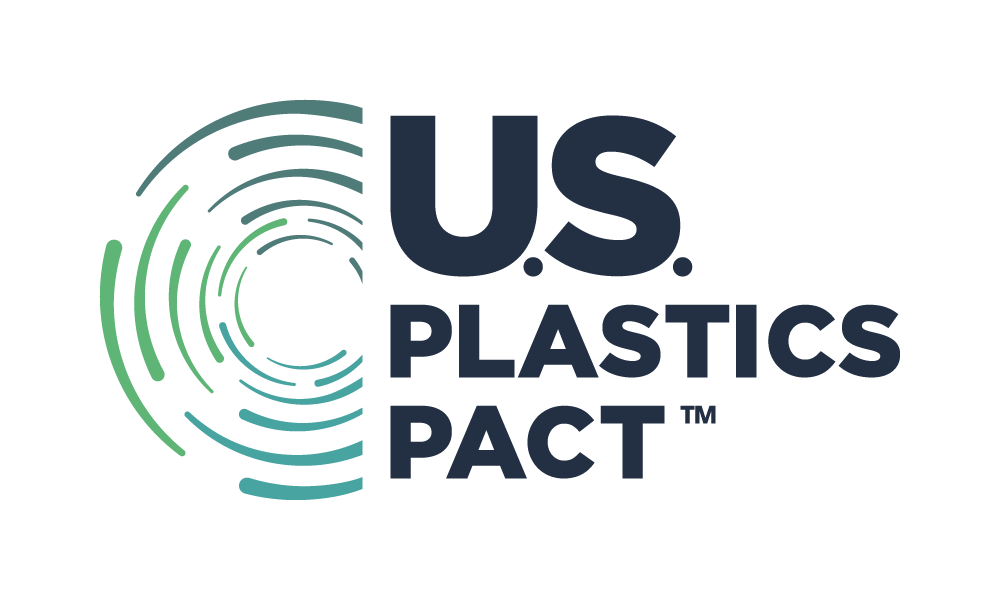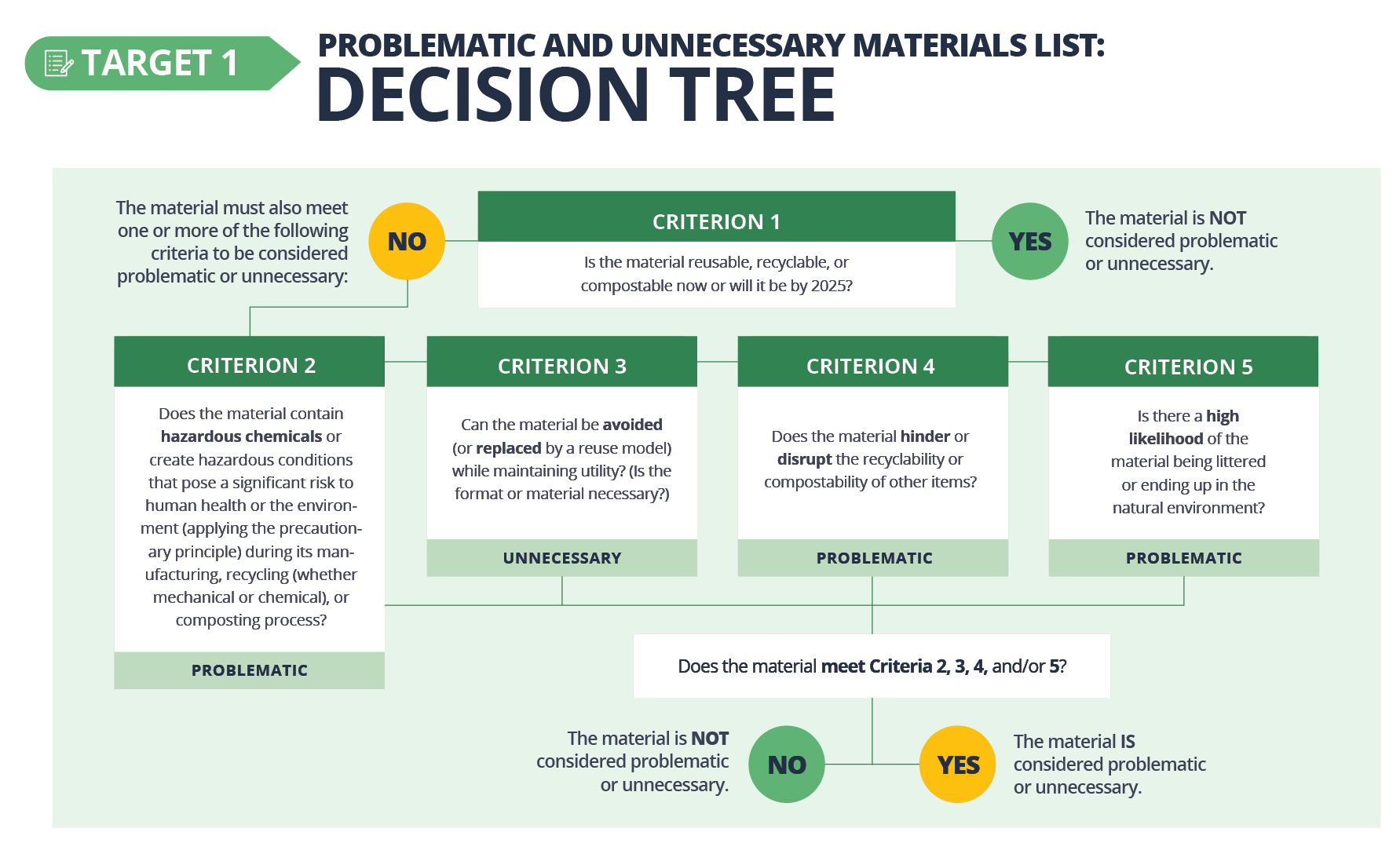The U.S. Plastics Pact works with its member Activators to take measures to eliminate problematic and unnecessary resins, components, and formats, in order to accelerate progress toward a circular economy for plastic packaging in the United States.
Definition of "Problematic or Unnecessary Materials"
Plastic packaging items, components, or materials where consumption could be avoided through elimination, reuse or replacement and items that, post-consumption, commonly do not enter the recycling and/or composting systems, or where they do, are detrimental to the recycling or composting system due to their format, composition, or size.
The U.S. Pact’s Problematic and Unnecessary Materials List
U.S. Pact Activators will take measures to eliminate the additional items on the list* by end of 2030 (the original 11 items are still scheduled to be eliminated by 2025):
- Cutlery¹
- Degradable and biodegradable materials that are not certified compostable, including bio-assimilating, oxo-degradable, oxo-biodegradable, and photodegradable materials used in plastics packaging.
- Foamed PET, including microfoaming and foamed layers for the purpose of lightweighting when they interfere with sortation and density requirements per the APR Design® Guide
- Intentionally added² Per- and Polyfluoroalkyl Substances (PFAS)³
- Multi-material⁴ Film and Flexible Plastic Packaging in applications that does not comply with the U.S. Plastics Pact Design for Circularity Playbooks, including:
- Multi-material film or bags for general merchandise (non-food items or dry goods that do not have a stated shelf life or best before date);
- Secondary multi-material film or bags for individually wrapped items (such as shrink wrap or an outer bag);
- Multi-material pallet stretch wrap;
- Multi-material bread bags;
- Multi-material cereal bags;
- Multi-material bags for fresh and frozen fruit;
- Multi-material bags for fresh and frozen vegetables (cook-in-bag products excluded)
- Multi-material⁴ Rigid Plastic Packaging that does not comply with the U.S. Plastics Pact Design for Circularity Playbooks
- Non-compostable Produce Stickers
- Non NIR-Detectable Pigments such as Carbon Black
- Opaque or Pigmented PET – Polyethylene Terephthalate bottles (any color other than transparent blue or green)
- Oxo-Degradable Additives, including Oxo-biodegradable Additives
- PETG – Polyethylene Terephthalate Glycol in rigid packaging
- Problematic Label Constructions – This includes adhesives, inks, materials (e.g., PETG, PVC, PLA, paper) except those that are APR Recognized or meet APR Preferred Guidance for coverage and compatibility
- PS – Polystyrene, including EPS (Expanded Polystyrene)
- PVC – Polyvinyl Chloride, including PVDC (Polyvinylidene Chloride)
- Stirrers¹
- Straws¹
*Participation in the U.S. Pact is voluntary and does not necessarily signify an individual Activator’s endorsement of the list.
1 When non-reusable, non-recyclable, or non-compostable per U.S. Pact definitions and provided as an ancillary item to the primary container. For instance, a packet of plastic cutlery provided with a prepared salad, or a straw/stirrer provided with an on-the-go beverage would be defined as problematic whereas cutlery, straws, or stirrers sold as a product would not.
2 “Intentionally added” either in the package or in the manufacturing of that package.
3 “PFAS” or perfluoroalkyl and polyfluoroalkyl substances are defined as the class of fluorinated organic chemicals containing at least one fully fluorinated carbon atom at or above 100 parts per million, as measured in total organic fluorine.
4 Multi-material packaging combines dissimilar materials (including labels, attachments, and other features of the complete package design) that are unable to be reprocessed together. Multilayer packaging, when constructed with mono-materials and compatible barriers, is acceptable as detailed in the U.S. Plastics Pact Design for Circularity guidance. Elimination is specific to multi-material packaging designs that do not comply with the Design for Circularity guidance. Mono-material packaging designs that meet the Design for Circularity guidelines are NOT considered problematic or unnecessary.
Process
The list was developed by U.S. Pact Activators, representing the expertise and experience of more than 100 organizations across the plastics packaging value chain. The materials on the list were evaluated in accordance with the criteria and definitions using the most comprehensive publicly available data from federal and state agencies, nonprofits, and trade associations. The list of sources is not exhaustive.
U.S. Pact’s adaptations to The Ellen MacArthur Foundation Global Commitment Criteria for identifying problematic or unnecessary plastic packaging components are provided in italics.
Exclusions
The list applies exclusively to plastic packaging. Medical plastics used in clinical, hospital, and related laboratory and research settings are not included. Definitions used in the criteria derive from the Ellen MacArthur Foundation’s global Plastics Pact Network, which provides the framework for the U.S. Pact. The U.S. Pact’s Roadmap to 2025 and Roadmap 2.0 focus on where the U.S. Pact and its member Activators can make the greatest impact. The most prominent resins, components, and formats are at the heart of this focus.

